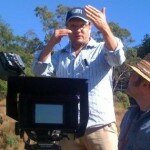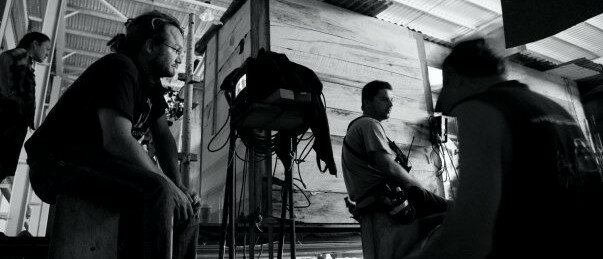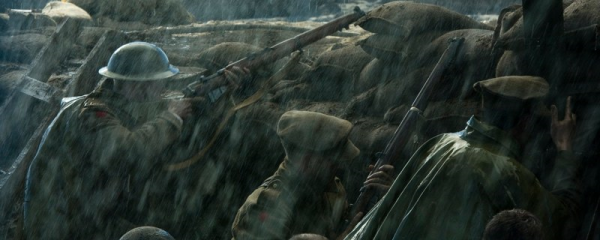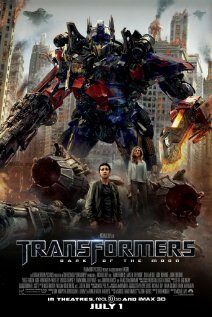Australian actor-turned-director Jeremy Sims first got his first taste in filmmaking in 2006 with Last Train to Freo, a taught low-budget thriller set almost entirely in the confines of a train carriage. Producer Bill Leimbach, while looking for a director who could make great use of limited space and a limited budget for an Australian war epic he was planning, saw Sims’ debut and knew he was the right man for the job. That film became Beneath Hill 60 and stars Brendan Cowell (of TV’s Love My Way) as Captain Oliver Woodward, one of 4,500 Australian miners tasked with tunnelling deep below enemy lines during the First World War. Woodward’s mission was to detonate an enormous explosive stockpile some 30 meters beneath Hill 60, a small but advantageous knoll held by the Germans along the Western Front in the flat plains of Flanders, Belgium. When it was eventually detonated on June 7th, 1917 along with 18 similar mines, the blast killed approximately ten thousand German soldiers and was heard as far away as London. It went down in history books as the largest man made explosion the world had ever seen.
While promoting the film for its April 15th release, director Jeremy Sims was kind enough to talk to Cut Print Review about working on a historically important war film with such a limited budget.
—
Cut Print Review: Beneath Hill 60 tells this absolutely incredible true story of significant historical importance that most Australians know next to nothing about. Why is that the case?
Jeremy Sims: The reasons are, in fact, threefold. One is that we know very few facts from the Western Front generally, even those battles that happened above ground. The various battles that the Australians were involved in have suffered by comparison to the great Gallipoli. So we are just starting to look again at what went on in a place where five times as many people fought and five times as many Australian soldiers died.
The second reason was that the whole tunnelling company, and the activities that they were up to, were secret for most of the war. For all of the war, actually. The fact there was a tunnelling company at all was not generally known and their activities were, for obvious reasons, kept secret during the war. Combine that with the fact that the actual act of fighting the war underground was, to some degree, considered un-gentlemanly. This is a time when people still thought – it’s only about ten years since the British stopped wearing bright red jackets, you know, to charge the enemy. War was changing rapidly during this period and the idea of setting off bombs underneath the enemy without facing them was something that the British and powers that be didn’t really want publicised.
The last reason is that a lot of them stayed on in Europe after the war to help repair bridges and stuff because they were all engineers. So they didn’t come back like the others and get involved in the parades and all of those things so their stories weren’t told. So you put all of those things together and they were forgotten part of the Australian war effort.
CPR: Did you have any relatives involved in the Great War?
JS: I had a great uncle who fought for the British infantry, but I don’t know much about that at all. But no, I’m a first generation Australia; my parents are English. So my discovery of all of that has been a part of my journey as well.
Jeremy Sims watches a scene being filmed via a video-split monitor
CPR: For research, did you travel to Flanders battlefields of France and Belgium?
JS: I did, I went to Ypres [pronounced EE-preh], which Australians tend to call Wipers. They have thousands of Australian’s going there every year. They all go to the Menin gate and hear the bugle play and then head off to look at the various cemeteries. Hill 60 is just a 10 minute bike ride out of Ypres and the crater is still there. There’s a little restaurant where you can have a schnitzel and a beer at Hill 60!
CPR: Yeah, I was actually there earlier this year and it was quite an experience. One thing I was simply blown away by just how much mud the soldiers had to face. Our battlefield tour guide told this story of a soldier being completely buried in the mud….while still on the back of his horse!
JS: Yeah, well a lot of people actually drowned in the mud. Once they’d gone into a crater, they just couldn’t get out.
CPR: How’d you go about recreating such horrible conditions in sunny Townsville, Queensland?
The one good thing about Townsville is that it’s incredibly flat. Surprisingly, the typography is not all that dissimilar to Flanders. This kind of huge, flat floodplain beneath a low-lying ridge, which is exactly what Flanders is. So we found a property that we could build the trenches on, but you have to remember that 70% of the film takes place in tunnels underground. So the main dugouts were built on that property, but the actual tunnel system itself was built in a massive warehouse on a different part of Townsville. That said, we found the flattest area and we found a place to put the trenches. This lovely guy who’s featured in the film – he’s the guy that gives them the directions to Hill 60 at night – he’s an earth moving contractor so he had all the equipment and stuff. He was a great help.
When we burnt off all the bush and ploughed it into the soil, it was very very dusty because it’s like 35°C and blue skies every single day in Townsville. So I couldn’t imagine how we’d do it; it was just dust. Everywhere. But once we actually dug down into the soil, we discovered that it was clay. All the way down to a riverbed about 8ft beneath the surface, which was about where we were putting the bottom of the trenches. Clayton Jauncey [Production Designer] and Sam Hobbs [Art Director] then built a massive sprinkler system which they buried into the dust and dirt and that was connected up to a huge water tanker. So when it was wet, it turned into mud and it looked exactly the same as Flanders mud. I know that when we dug the backhoe in for the first time, and saw that it was clay, we were really, incredibly happy.
CPR: I hear the Townsiville community really got behind the film. What were some examples of their involvement?
JS: One of the local third-grade rugby teams came one day as part of their pre-season training and filled sandbags for us. I think they filled about two thousand sandbags in total, which was fantastic. Of course, they were also our British rugby players in that sequence and extras in signing the group song.
We also go a massive, brand new Industrial shed from Brad Webb Industries up in Townsville, which he provided to us. It didn’t look like it was going to be finished in time and he put extra people on the job who worked double-time to get it finished. It was big enough to hold a 747 and we filled it twice with tunnels!
Really, the whole of Townsville knew we were there. We got great support from the local newspaper and ABC radio station. Just across the board we got support: scaffolding companies, cherry pickers and all sorts of things.
CPR: I’m sure that played a part in keeping under budget, which at just 9.6 million, is pretty meagre for a war film. What were some of the secrets to keeping costs down?
JS: The primary reason was that we had a 7 week shoot. The first cut of the film came in at a 145 minutes, so you can see that to shoot that much quality drama in just 7 weeks was a major logistical effort. There was a shitload of planning involved. I needed to be really prepared. The whole film was storyboarded and a large document was sent out to all the heads of department with every scene and every shot I was proposing to shoot. We did lose a few little things; there was a sequence early in the film that was going to have Woodward in Papa New Guinea leaving his old job, but about 3 weeks out of the start of the shoot we realised we just didn’t have time. Let alone the money.
We shot 6 day weeks, so people just worked incredibly hard. The other thing is that I have a background in the theatre, so I’m very used to making sure you don’t spend any more money than you need to make something look like it needs to look. There’s a certain amount of artistry involved in doing that kind of stuff.
 Shooting in the trenches of Townsville
Shooting in the trenches of Townsville
CPR: If you had, say, 10 million dollars more to spend, where do you think you would have spent it?
JS: [pauses] I would have had twice as long to shoot the film, probably. We may have shot a few more scenes above ground. But I really can’t imagine it to be honest. The limitations were what made the film. I certainly wouldn’t make it any longer. I think we would have got really indulgent, probably. Limitations are the absolute lifeblood of creativity, you know? That’s why three chords are all you need to make great blues.
CPR: Try telling Hollywood that!
JS: Yeah, it is an issue. How many times have you gone and seen a Hollywood film and thought ‘Oh god, in the last half hour alone they spend a $100 million…and I was bored.’
CPR: Hello, Clash of the Titans…
JS: [laughs] Yeah, exactly. So that’s why limitation is the mother of invention. I wouldn’t actually have wanted any more money.
CPR: You’ve amassed a great Australian cast headed by Brendan Cowell as Frank Woodward. What made him standout during auditions?
JS: Oh I didn’t audition Brendan, really. We’re old friends; I’ve directed him on stage a couple of times. I worked early on with David Roach [Writer] on wanting to have an Australian everyman in the lead character. Someone that we wouldn’t get to know too quickly, someone we’d still be working out halfway through the third act. And really, when you look at our [Australia’s] main A-list male actors, most of them are in their 40s now. So they weren’t an option. There’s another bloke called Sam Worthington…
CPR: [laughs] I think he’s been a bit busy lately…
JS: [laughs] Yes, he was busy at the time. And really, in my mind, he’s kind of way to heroic for the role. I wanted someone that has the range, he can be funny, serious, wacky, ironic…he can be it all. It was a really tough gig; he was on set all day, every day. Covered in mud and shit for 7 weeks.
CPR: I recall hearing last year that Hugo Weaving was attached to star in the film as one of the other diggers. Was losing a big, international name such as his a big blow for you?
JS: Oh look I was very hopeful that Hugo would come and do it, but I think in the end the role wasn’t big enough for him to move heaven and earth to get there and do it. Well, the other thing is that the other really great role in the film is the role of [Bill] Fraser and I always wanted Steve Le Marquand to play it; it was written for Steve. So there wasn’t really a question of bringing an international name into it. To be honest, this film will stand or fall on the strength of the quality of the film and the nature of it being a war film. It’s not a star vehicle… at all.
I’m really thrilled that Jacqueline [Mckenzie] did a few scenes and Aiden [Young] did a scene or two. I also love the fact that John Stanton is there as the general. You know, they’re all friends of mine and the quality of acting in the film is extremely high.
The rain was a digital effect added in post production
CPR: One of the reasons floating around why Weaving didn’t come on board was because of his claustrophobia which being in the tunnels would have set off. Was it difficult shooting under tight conditions?
JS: Yeah, again, the limitations were the making of it. If it were a Hollywood film, the whole set would have been breakaway set. There would have been lots of room for technicians to get in and out and stuff. I made a rule very early on that unless we absolutely had to, for reasons of safety, the camera would be in the tunnel with the men. If they couldn’t get the camera there, then we couldn’t get the shot.
CPR: How did cinematographer Toby Oliver like you for that rule?
JS: Well Toby’s very much a pro. He made my first film with me [Last Train to Freo] and we had the same rule inside the train carriage. So that really helped us, knowing what we could and couldn’t do. In terms of making it difficult for him, it was actually the opposite; the candlelight on the wood and dirt ceilings and walls was an incredible canvas for Toby to work with. As he said in one of his interviews, he couldn’t point his camera anywhere that wasn’t interesting because the backgrounds were just so fantastic. Clayton Jauncey [Production Designer] will take a huge bow tomorrow night when we open because of his tireless work. The production design is the main star of the film.
CPR: Producer Bill Leimbach was quite adamant that this was going to be a ‘classic’ right from the word go. That’s a lot of pressure placed on you!
JS: Well, we wouldn’t have got the film up without Bill’s optimism. He’s an old school Hollywood producer, or how I imagine them back in the 30s and 40s. You know, he just wouldn’t take no for an answer. He knew exactly what he wanted to make, even if he didn’t quite know how he was going to do it. We changed our model a lot of times, which was difficult and frustrating, but the one thing that never wavered was his absolute belief and optimism in what he was making. I think a lot of producers in Australia could learn a thing or two from Bill.
CPR: Well, that’s my 15 minutes up. Thank you for your time Jeremy and best of luck with the film!
JS: Thanks Anders!
—
Beneath Hill 60 opens in Australia on April 15th 2010.
 Follow the author Anders Wotzke on Twitter.
Follow the author Anders Wotzke on Twitter.










![The Troll Hunter [Trolljegeren] (Video Review)](/wp-content/uploads/1102_the-troll-hunter-150x150.jpg)

